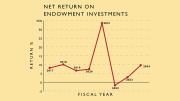Packing the Earth’s 4.6-billion-year history into a two-foot-by-three poster—roughly three-quarters of a billion years per square foot—is no easy task. Yet scientists from Harvard and the Howard Hughes Medical Institute (HHMI) in Chevy Chase, Maryland, have teamed up to do just that with “Earth Evolution: The Intersection of Geology and Biology”—a graphic display (opposite) of how geological and biological processes have dynamically shaped and molded the world we inhabit.
Classic visualizations of life on Earth typically pick up the tale 540 million years ago, when oxygen, land plants, and certain marine invertebrates became abundant. “Earth Evolution” tells a much longer and more complex story, stretching back to the earliest evidence of life. “For the first several billion years of Earth’s history, it was a world of bacteria and archaea—only somewhat later in the game did we have eukaryotes,” says Fisher professor of natural history Andrew Knoll, referring to single-celled microorganisms and organisms whose cells contain a membrane-bound nucleus, respectively. “The most ancient history most students have thought about—like trilobites or dinosaurs—is really only the last 10 or 15 percent of the history of the planet and the history of life,” continues Knoll, who worked closely with HHMI on the poster. (For more on Knoll’s research into the origins of life, see “Life’s Beginnings.”)
Using explanatory illustrations, the poster draws connections between biological and geological processes in Earth’s history, including discussions of plate tectonics, chemical cycles, the greenhouse effect, early photosynthesis, and, significantly, the oxygenation of the planet. The story of oxygen, in fact, is really the story of Earth. Knoll and his colleagues at HHMI have therefore divided the planet’s history into three broad chapters based on this all-important gas: a long first chapter without oxygen, which lasted until about 2.4 billion years ago; an almost equally long second chapter when the planet had some oxygen, which lasted until roughly 550 million years ago; and finally, the most recent era, characterized by large amounts of the gas.
The poster also addresses climate change—there is a “key events” section on the left-hand side depicting the greenhouse effect as well as the geologic carbon cycle and mass extinctions. “In the Phanerozoic Eon—the ‘age of visible animals’ that began 541 million years ago—mass extinctions have punctuated evolutionary history,” Knoll reports. Although some are thought to have been caused by large meteorites, he explains, “several are tied to massive volcanism, which caused a rapid increase in atmospheric carbon-dioxide levels. The one process we know that increases CO2 at rates comparable to those of massive volcanism is human industrial activity, thus linking our biological past and future.”
Given their target audience of high-school students, Knoll said he and the HHMI team were careful to avoid jargon and too much detail even as they tried hard not to “dumb down” concepts. “Earth has been a biological planet through most of its history,” he says, and “every kid has heard about dinosaurs,” yet they seem “much less likely to have heard how we can reconstruct [Earth’s] environmental as well as biological history. This interesting picture of interactions over time is not so common.”









